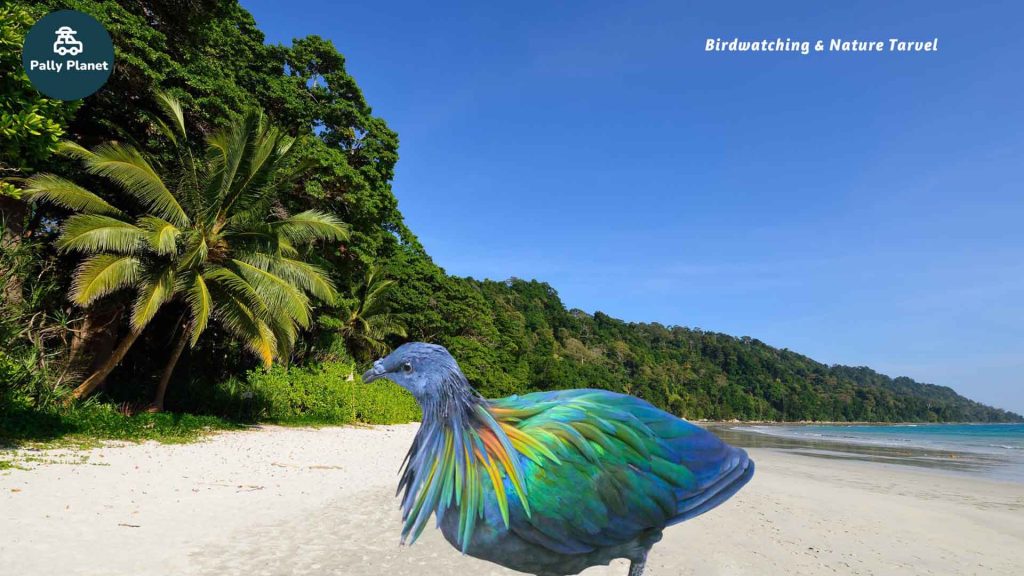
Only a few places on the planet are still inaccessible to serious birders. Greater Nicobar, an Indian Ocean island located more than 2,000 kilometres from the mainland, is one such location. Despite the title “Nicobar,” most birding and eco-tourism itineraries and advertisements on the internet only cover the Andaman Islands. This is primarily because the archipelago is treated as a single administrative entity known as the “Andaman and Nicobar Islands,” although the two island clusters are located more than 500 kilometres apart. As a result, when planning your trip, make sure that “Greater Nicobar Island” is on the itinerary.
The Nicobar Islands are a tropical paradise with lush forests teeming with exotic plants and birds, stunning coral reefs, and miles of pristine white sand beaches. It is also home to enigmatic local tribes.
I recently went on a birding tour to Greater Nicobar. The overnight boat trip from Andaman to Nicobar proved to be less taxing than I had anticipated. Let me address a few common concerns that people have when considering a trip to the Nicobar Islands.

Where exactly is Greater Nicobar?
Greater Nicobar is an Indian island in the Bay of Bengal, located in the southernmost part of the Nicobar archipelago. It is located closer to Indonesia than India’s mainland and is known for its beautiful beaches and diverse wildlife, including various bird species. The nearest airport is in Andaman, about 500 kilometres away.
Why are there so many restrictions on visiting Nicobar?
There are several reasons for the travel restrictions to Nicobar. To begin with, the island is a tribal reserve, which means it is inhabited by indigenous tribes who are legally protected from outside interference. Second, the island is strategically located near international shipping lanes, making it vulnerable in terms of security. Finally, the island’s ecosystem is vulnerable and must be safeguarded against the negative effects of tourism.
How can one travel to Great Nicobar?
There are two ways to get from Port Blair (Andaman Islands) to Campbell Bay (Greater Nicobar). The most convenient option is to take a ship journey that can last more than 30 hours. Regularly, two large ships sail between the two Islands. However, the shipping schedule is NOT always reliable. Any sudden changes in weather, unscheduled stops in one of the smaller islands etc., can disrupt your travel plans. Therefore, when planning a trip to Nicobar Island, you must have a bendable itinerary to accommodate such unforeseen delays.
A helicopter ride to Nicobar is also not an option that is reliable. Finding a seat on the helicopter is always difficult because the authorities prioritise the travel needs of governmental officers and Nicobar residents’ medical evacuations over tourists. It is both fair and understandable.
Normally, ships simultaneously depart at 10 a.m. on alternate days from their arrival and departure points, i.e. Port Blair and Campbell Bay. The ship will anchor in Central Nicobar Islands for a few hours. This stopover would be a fantastic opportunity to see the birds of Central Nicobar. Your guide will know how to arrange a taxi to take you to see Nicobar Sparrow Hawk, Nicobar Bulbul, Grey Night Jar, and other birds before returning to your ship on time. Landing on the Island requires a separate pass, so make sure to mention it to the ticket clerk when purchasing your ticket.
How are the Accommodations in Greater Nicobar?
There are currently only two reliable accommodations available for visitors to stay in, but more are likely to open in the future due to the government’s new tourism policies for the Island. The two mentioned places are the government guest houses, which are adequate for a few nights’ stay on the Island. Both guest houses do not have on-site restaurants, but nearby hotels can easily arrange food. To avoid last-minute complications, I strongly advise making reservations well in advance.
What are the Nicobar endemic bird species?
Nicobar is an excellent destination for bird watchers, as the island is home to several endemic bird species. The Nicobar megapode, Nicobar pigeon, Nicobar parakeet, and Nicobar scrubfowl are among the key species to look out for. Nicobar also has a few Andaman and other regional species.
When is the best time to go bird-watching in Greater Nicobar?
The period between November to March is ideal for birdwatching in Great Nicobar. The weather is pleasant, the sea is calmer this time of year, and bird species are more active and visible.
What else is there to do in Greater Nicobar?
Greater Nicobar is a pristine island known for its picture-perfect beaches and verdant forests. It is ideal for trekking through lush forests and visiting local markets to experience the Nicobar Islands’ unique culture and cuisine.
Can you visit Little Nicobar while visiting Greater Nicobar?
Visiting Little Nicobar while visiting Greater Nicobar is possible, but visitors must first obtain permission from the Indian government.
Who organised my birding trip to Greater Nicobar, and how can they be reached?
Dhanish Trogon organised my birding trip to Greater Nicobar. For all of my Andaman and Nicobar trips, he is a dependable and knowledgeable tour operator who can be reached via email at [email protected].

